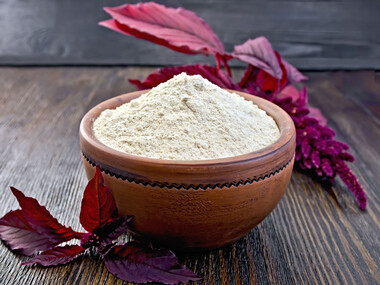
For Central and South American indigenous peoples, amaranth was the basis for indestructible health through a concentrated load of easily utilisable nutrients and vital substances. Fortunately, an Australian scientist rediscovered amaranth in the 1970s rather by chance and first described its unusual lysine content. All the molecular components important for human nutrition are contained in an almost perfect ratio in every grain of amaranth. And dogs also benefit nutritionally from the almost inexhaustible vital substance content of the super grain.
9000 years in the past: A tribe buries its chief in a burial chamber near today's Veracruz on the Gulf of Mexico and gives him weapons, jewellery and other marvels for his journey into the afterlife. But the chief also receives something else for his last journey: a bag with a miraculous grain that we call amaranth today. It was considered one of the staple foods by the ancestors of the Incas and Aztecs in Central and South America - but much more, because for the indigenous people of the region, amaranth was the basis for indestructible health through a concentrated load of easily usable nutrients and vital substances. It almost goes without saying that the deceased chief was to be nourished by it in the afterlife.
Amaranth was considered a heavenly gift by the indigenous peoples.
Incidentally, the name "amaranth" still reminds us of this effect as a miracle plant: it comes from the Greek "amàranthos" and means something like "not withering" or "immortal". The name is indicative of the power inherent in this plant. And so the Incas and Aztecs in Central and South America (roughly between the 13th and 16th centuries) also attributed life-prolonging effects, indeed downright magical powers, to the grains, which are said to have been brought to the indigenous peoples by a sacred bird as a heavenly gift. Amaranth, for example, was regarded as a fountain of youth in old age, a tonic for pregnant women and the sick and a growth promoter for children and young people, and was at the centre of many ceremonial acts.
This then led to its disappearance. The Spanish conquerors around Francisco Pizarro were suspicious of the plant because the Indians also used it in their human sacrifices. Without further ado, they made the cultivation of amaranth punishable by death. However, even the most massive prohibitions and draconian punishments could not prevent amaranth from continuing to be cultivated on small clods in the high mountains.
Lysine is one of the essential protein building blocks.
Fortunately, one has to say today, because after about 500 years in slumber, an Australian scientist rediscovered amaranth in the 1970s rather by chance and first described the unusual lysine content. Lysine is one of the essential protein building blocks (amino acids). The breakthrough in the United States came with the nutritionist John Robson, who was the first to point out the multitude of valuable nutrients in amaranth.
Amaranth has a concentrated load of easily utilisable nutrients and vital substances that no conventional grain can match. The tiny amaranth grains are smaller than mustard seeds, so it is possible for up to 50,000 grains to mature in a single amaranth plant. Today, amaranth is mainly cultivated in South and Central America as well as in Europe. At about 66 grams, the carbohydrate content of amaranth is significantly lower than that of grain. This is particularly interesting for those people who pay attention to a low-carbohydrate diet. At the same time, the carbohydrates contained in amaranth are very easy to digest and are quickly available to the body in the form of long-lasting energy. The fat content of amaranth, on the other hand, is about nine grams in total, 70 percent of which consist of unsaturated fatty acids. These include the well-known omega-3 fatty acid and linoleic acid (omega-6 fatty acid). These are two essential fatty acids that the body cannot produce itself and consequently has to take in through food.
Even if it may sound crazy: All the molecular components that are important for human nutrition are contained in an almost perfect ratio in every grain of amaranth. The nutrient content of 100 grams of amaranth, for example, corresponds practically exactly to the nutritional recommendations of the German Nutrition Society (DGE) for daily nutrient intake with regard to carbohydrates and protein!
Dogs also need amaranth for good nutrition
And what is good for humans does no harm to their best friends, dogs. Whether puppies or adult four-legged friends - they all benefit nutritionally from the almost inexhaustible vital substance content of the super grain amaranth, which is contained in the "CBD dog biscuits" from Natura Vitalis. In addition to the important unsaturated fatty acids, amaranth contains a high proportion of lecithin. This multi-talent is especially important for nerve and brain function and for a healthy cholesterol balance. In addition, this grain of the Inca provides a wealth of minerals (magnesium, calcium, etc.), trace elements (zinc, iron, potassium, etc.) and vitamins - more than in real and conventional grains or comparable other foods.
With an almost perfect amino acid profile, amaranth also tops almost all comparable grains and thus provides all amino acids that are vital for dogs - with an extremely high biological value. The protein content is an incredible 15 percent. A study confirms that amaranth is the optimal additional source of protein, for example on a meat-free diet. Speaking of meatless: L-carnitine, which is normally only found in meat, is also found in the amaranth plant. Thus, the L-carnitine needed for energy and fat metabolism from food is also made available to the body through this.
This text may contain translation errors as the translation was done by
an online translation tool.










